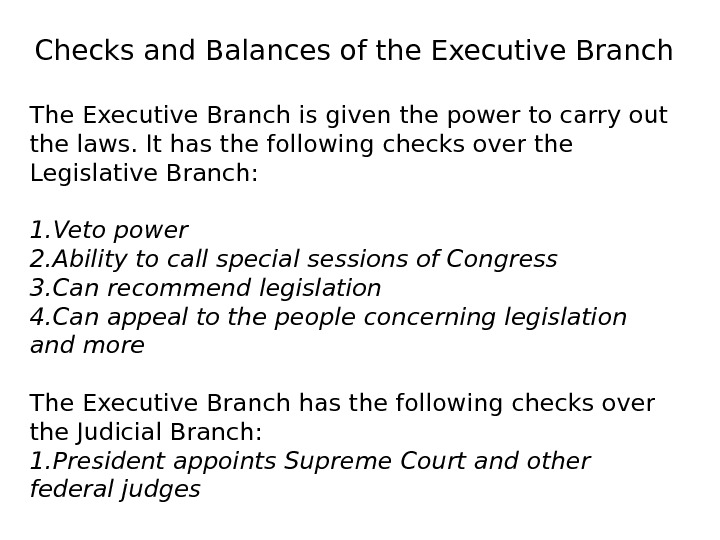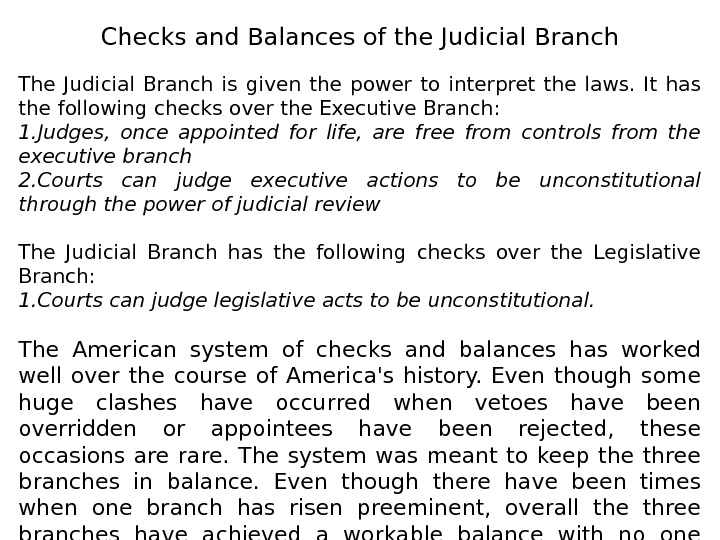THE SYSTEM OF CHECKS AND BALANCES The






- Размер: 138.5 Кб
- Количество слайдов: 5
Описание презентации THE SYSTEM OF CHECKS AND BALANCES The по слайдам
 THE SYSTEM OF CHECKS AND BALANCES
THE SYSTEM OF CHECKS AND BALANCES
 The system of checks and balances is a part of our Constitution. It guarantees that no part of the government becomes too powerful. For example, the legislative branch is in charge of making laws. The executive branch can veto the law, thus making it harder for the legislative branch to pass the law. The judicial branch may also say that the law is unconstitutional and thus make sure it is not a law. The legislative branch can also remove a president or judge that is not doing his/her job properly. The executive branch appoints judges and the legislative branch approves the choice of the executive branch. Again, the branches check and balance each other so that no one branch has too much power.
The system of checks and balances is a part of our Constitution. It guarantees that no part of the government becomes too powerful. For example, the legislative branch is in charge of making laws. The executive branch can veto the law, thus making it harder for the legislative branch to pass the law. The judicial branch may also say that the law is unconstitutional and thus make sure it is not a law. The legislative branch can also remove a president or judge that is not doing his/her job properly. The executive branch appoints judges and the legislative branch approves the choice of the executive branch. Again, the branches check and balance each other so that no one branch has too much power.
 Checks and Balances of the Legislative Branch The Legislative Branch is given the powers to make the laws. It has the following checks over the Executive Branch: 1. May override presidential vetoes with a two-thirds vote 2. Has the power over the purse strings to actually fund any executive actions 3. May remove the president through impeachment 4. Senate approves treaties 5. Senate approves presidential appointments The Legislative Branch has the following checks over the Judicial Branch: 1. Creates lower courts 2. May remove judges through impeachment 3. Senate approves appointments of judges
Checks and Balances of the Legislative Branch The Legislative Branch is given the powers to make the laws. It has the following checks over the Executive Branch: 1. May override presidential vetoes with a two-thirds vote 2. Has the power over the purse strings to actually fund any executive actions 3. May remove the president through impeachment 4. Senate approves treaties 5. Senate approves presidential appointments The Legislative Branch has the following checks over the Judicial Branch: 1. Creates lower courts 2. May remove judges through impeachment 3. Senate approves appointments of judges
 Checks and Balances of the Executive Branch The Executive Branch is given the power to carry out the laws. It has the following checks over the Legislative Branch: 1. Veto power 2. Ability to call special sessions of Congress 3. Can recommend legislation 4. Can appeal to the people concerning legislation and more The Executive Branch has the following checks over the Judicial Branch: 1. President appoints Supreme Court and other federal judges
Checks and Balances of the Executive Branch The Executive Branch is given the power to carry out the laws. It has the following checks over the Legislative Branch: 1. Veto power 2. Ability to call special sessions of Congress 3. Can recommend legislation 4. Can appeal to the people concerning legislation and more The Executive Branch has the following checks over the Judicial Branch: 1. President appoints Supreme Court and other federal judges
 Checks and Balances of the Judicial Branch The Judicial Branch is given the power to interpret the laws. It has the following checks over the Executive Branch: 1. Judges, once appointed for life, are free from controls from the executive branch 2. Courts can judge executive actions to be unconstitutional through the power of judicial review The Judicial Branch has the following checks over the Legislative Branch: 1. Courts can judge legislative acts to be unconstitutional. The American system of checks and balances has worked well over the course of America’s history. Even though some huge clashes have occurred when vetoes have been overridden or appointees have been rejected, these occasions are rare. The system was meant to keep the three branches in balance. Even though there have been times when one branch has risen preeminent, overall the three branches have achieved a workable balance with no one branch holding all the governmental power.
Checks and Balances of the Judicial Branch The Judicial Branch is given the power to interpret the laws. It has the following checks over the Executive Branch: 1. Judges, once appointed for life, are free from controls from the executive branch 2. Courts can judge executive actions to be unconstitutional through the power of judicial review The Judicial Branch has the following checks over the Legislative Branch: 1. Courts can judge legislative acts to be unconstitutional. The American system of checks and balances has worked well over the course of America’s history. Even though some huge clashes have occurred when vetoes have been overridden or appointees have been rejected, these occasions are rare. The system was meant to keep the three branches in balance. Even though there have been times when one branch has risen preeminent, overall the three branches have achieved a workable balance with no one branch holding all the governmental power.

